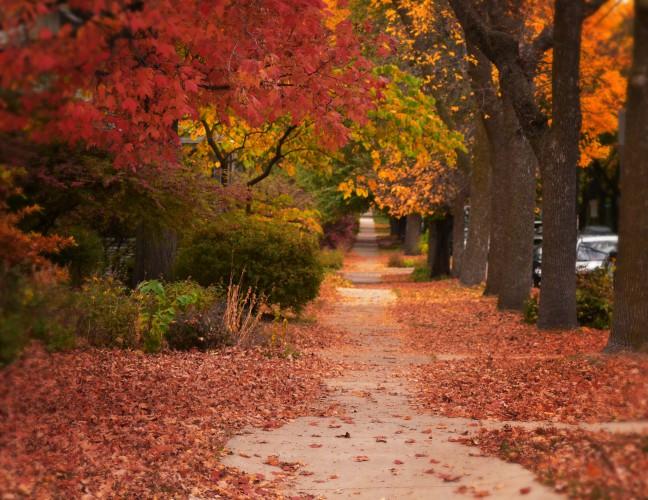Colorful falling leaves may be a trademark of autumn, but if left on the street, they can have a detrimental effect on Lake Mendota and Lake Monona.
A 2019 study by the U.S. Geological Survey in Madison found that after fall leaves pile up, they begin to break down and leak phosphorus. When it starts to rain, the water washes “leaf litter” down the storm drains, which then empty into lakes. Phosphorus is a natural element that promotes plant growth. When in excess, it leads to the overgrowth of algal blooms and cyanobacteria in lakes, which are harmful to other aquatic life and humans.
Clean Lakes Alliance, a Madison-based nonprofit, is dedicated to protecting Wisconsin’s Yahara River Watershed, which includes Lake Mendota and Monona. Clean Lakes Alliance Watershed Initiatives senior director, Paul Dearlove works to reduce phosphorus leakage at the community level and empowers citizens to take an active role in preserving the lakes.
“One pound of phosphorus can generate up to 500 pounds of wet algae growth, so it’s this huge multiplier effect,” Dearlove said. “That’s why we keep trying to keep phosphorus out of the stormwater, and leaves are the biggest source of urban phosphorus.”
According to the U.S. Geological Survey study, fall leaf litter can produce about 60% of the total annual phosphorus that comes from urban areas into lakes.
Leaves are everywhere in nature, so it can be difficult to imagine them posing a serious threat, but according to the Clean Lakes Alliance, human activities accelerate the rate and amount of phosphorus that enters the lakes. Compared to a natural landscape, there aren’t plants or soil to absorb the “leaf litter” before it can reach the lakes.
“Stormwater is this conveyor belt of pollution if we don’t manage the landscape in an effective, conservation-minded way,” Dearlove said. “Changes to the natural landscape in the form of parking lots, paved streets and storm drains provide the phosphorus with a quicker pathway to our lakes.”
According to the nonprofit World Resources Institute, the phosphorus-facilitated growth of algae blooms and cyanobacteria in lakes depletes oxygen in the water. The algae and cyanobacteria form a layer on the water’s surface which blocks other aquatic plants from doing photosynthesis. In addition to taking up nutrients, these organisms can also secrete harmful toxins.
“When those algae or bacteria cells die, they can release a toxin that can be really harmful to fish, other aquatic life, even people and pets,” Dearlove said. “That’s why there are waterfront closures to keep people from using the water when a situation like that is unfolding.”
Dearlove said because a large amount of the phosphorus pollution occurs from early October to late November, citizens, municipalities and organizations can address the issue in a concentrated timeframe.
Madison provides a leaf and yard waste collection service for residents where the collected leaves are taken to a compost facility. The city’s website provides a space for residents to learn more about how to prepare their yards for leaf collection and set a date for pick up.
Dane County also has a Leaf-free Streets Rain Alert service that will remind residents via text or email to take the leaves off the streets right before it rains, which is a crucial time for leaf removal.
Organizations like Clean Lakes Alliance provide communities with additional opportunities to participate in the effort. Clean Lakes Alliance Watershed engagement specialist Caitlin McAleavey focuses on volunteer engagement and watershed-related programs that help people connect with the lakes.
“In thinking about college students in particular, they have a large voice and a lot to say when it comes to things like our lakes,” McAleavey said. “They are definitely a huge component of our community too, which is what we at Clean Lakes Alliance want to engage. We want our community as a whole to see that the lakes are a really important asset that we have and something worth protecting.”
The University of Wisconsin campus is right between Lake Mendota and Monona, which provides students and organizations with a variety of opportunities to contribute to protecting the lakes and the environment. The UW Arboretum and the Lake Shore Preserve welcome student volunteers.
Students are also finding ways to contribute in their own meaningful ways. Students interested in graphic design are spreading awareness by helping with campaigns and logos for events around this issue. McAleavey said sororities and fraternities are partnering with organizations like Clean Lakes Alliance to help rake leaves on Langdon Street. They are currently planning an event with the UW Alpha Chi Omega sorority chapter and the UW Acacia fraternity chapter.
“We have engineering classes doing UW capstone projects, so they look at how we can redesign, for instance, our lakeside parks and beaches to be more sustainable and accessible to people,” Dearlove said. “In the end, it’s all about individual action, and the cumulative impact of those small individual actions is what really adds up and makes a big difference.”


